|
Xiashan's Hakka Lion
Writing.Photography/Amy Chang
Introduction to Xiashan
Driving on the narrow and curved country road that allows only one car passing, you can even touch the rice at sides of the road if rolling down the window. In this lovely countryside, the peasant quit laboring in the rice fields before sunset, at night, they still have something meaningful to do. You may wonder what is that?
Xiashan locates in northern Taiwan, is a small village in Qionglin, Hsinchu County. Though that large-scale rice fields in Taiwan mainly are in southern plains, still some rice fields are in north Taiwan where Xiashan contributes to rice harvest, is one of the barns of Hsinchu county. More than just a barn, an honor to Xiashan, as early as at the time Taiwan was governed by Japanese, rice from Xiashan for its excellent quality was the tribute to Japanese emperor.
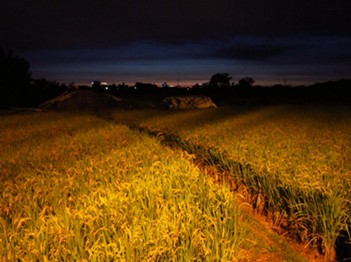
Above: the rice field in front of the Hakka Lion practicing ground in Xiashan village. The farthest is the HSR (High-Speed-Rail) that brings in the industries and the prosperity.
Xiashan is a typical Hakka village. "Hakka" is a big tribe in Taiwan. Information from Hakka Affairs Council, according to the 2004 Taiwanese Hakka population survey, there is one Hakka for every 3.7 individuals. Obviously, the Hakka population in Taiwan is huge. Hsinchu county is one of the Hakka living areas in north Taiwan.
Then how small Xiashan is? March, 2010, in Xiashan, household number was 433 with 746 male and 665 female, a total of 1,411 people in Xiashan. However, this doesn't stop Xiashan to demonstrate the village vitality that the 8-year-old to 87-year-old all together.
The ties in the village
Hakka is recognized to be very diligent and united, surely would fight together if any invaders. In early days, "Invaders" meant robbers and bandits, still were the autochthon and people from Fujian, another big tribes, the majority immigrants to Taiwan as Hakka did. Hakka organized territorial, learnt martial arts not only for body building also to protect their people and their land. The defensive, to be effective, they learnt how to use the "weapon" that can be obtained easily, such as the umbrellas, cloth wrappers (i.e. bags today) and smoking pipes, etc., all became the fatal weapons. Xiashan did the same as all Hakka did, thus the martial arts were in the village and later was combined into Hakka "Lion Dancing" become a very unique performance called "Full-Shed Lion". In the hayday, 4 Hakka Lion Dancing troupes were in the village, they were Chang, Cheng, Tien and Huang families.
The lion dancing also used to perform during Chinese New Year celebration, passed the happiness from house to house.
Regretfully, by the influence of the industrialization that changed the living in the village, the troupes had been dismissed and disappeared for decades.
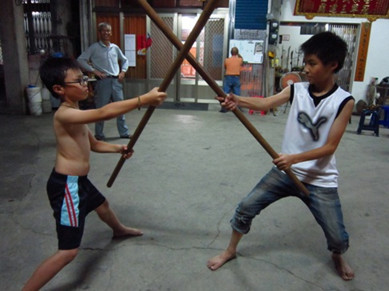
Children and adult, male and female are practicing the martial arts.-1
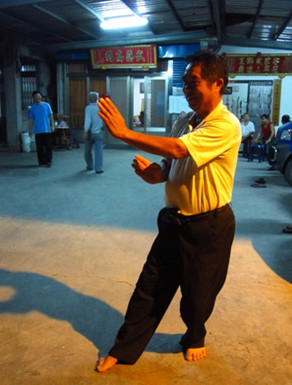
Children and adult, male and female are practicing the martial arts.-2
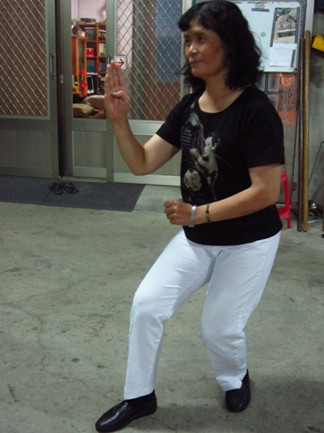
Children and adult, male and female are practicing the martial arts.-3
About Hakka Lion and Lion Dancing Troupe
Lion, king of animals, has its image of horrifyingly ferocious, however, when it becomes a mask for dancing, people might like it to be lovely with opened mouse for smiling not for hunting.
Open-mouth lion is one of the features of Hakka Lion mask, Mr. Jian-An, Chang, the leader of Chang's lion dancing troupe said, the lion's mouth can open and close is a remarkable feature, when every clench teeth means to resist all challenges and ride out of the storms; in the meanwhile, the open-mouth lion can smile that represents the optimistic spirit of Hakka. Other features include the Eight Trigrams on the top of the mask; Hakka lion is well versed in both polite letters and martial arts with symbols "pen" on the left face and calabash on the right face of the lion mask. Mr. Chang explained, calabash with its big belly can contain the varieties. One morefeature of Hakka lion mask is the round shape on the upper half and square shape on the lower half. The round on the upper half says the sky and square shape on the lower half means the ground, that's the universe. See pictures as below.
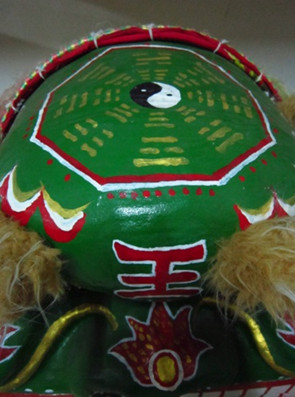
Eight Trigrams on the top of the mask1
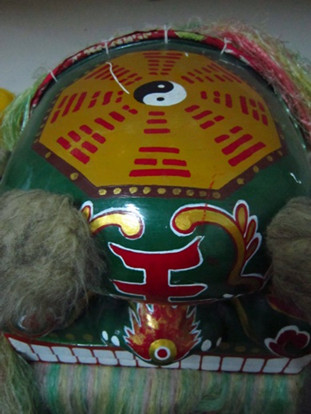
Eight Trigrams on the top of the mask2
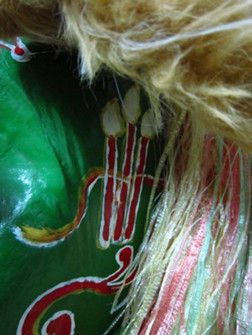
symbols on the right and the left of the lion mask1
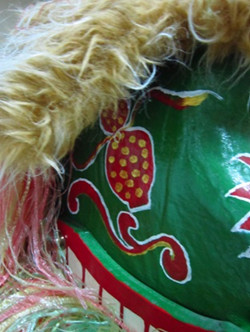
symbols on the right and the left of the lion mask2
As for the aforementioned, the "Full-Shed Lion", Mr. Jian-An Chang explained, it means the performance that combines the Hakka lion dancing (go first) and the martial arts (follow later), is a complete performance to demonstrate the Hakka culture. Normally it takes about 2 hours for a whole play.
Such a great performance would require at least 30~40 people on the stage. Both lion dancing and martial arts are energy consuming. The troupe population in Chang's group is 60~70 people. They get together for practice three times a week, Monday, Wednesday and Friday. Both genders are acceptable without sexism. The youngest member is an 8 years old boy and the eldest is at his 87, is the youngest uncle of Jian-An Chang. The other members most are within 60~70 years old some with martial art experience for over 40 years. This troupe earned victories in many competitions.
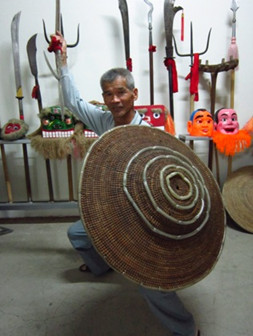
Jian-An Chang, is showing all weapons made by himself
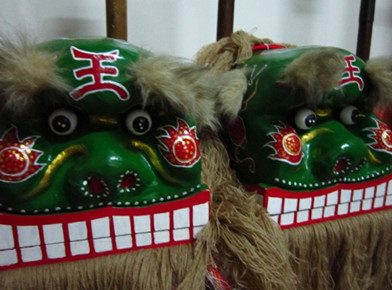
Xiashan Hakka Lion Mask
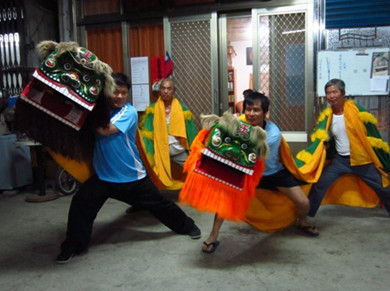
The troupe members with the open-mouth Hakka lion mask
Now, in Xiashan, besides Mr. Chang's lion dancing, in the 4 lion dancing families ever, Cheng is another that still makes effort for culture passing down.
Same as "Chang", "Cheng" is a family name, their ancestors arrived in Xiashan 150 years ago, was the pioneer who brought the wasteland under cultivation, built their ancestral temple beneath Mt. Feifeng. Cheng's family temple is now over hundred years. Such a big family at its peak times, over 100 people living together, also had a large family property, they hired martial art masters to teach to protect themselves, thus the group of lion dancing.
Community Empowerment
In recently years, worked together with Xiashan Community Development Association, Jian-An Chang from Chang family and Shu-Mao Cheng from Cheng family have been devoting to Hakka Lion Dancing, for developing and teaching. They provide opportunity to whom would like to learn about the Hakka Lion Dancing, also spend times for the teaching of lion mask making. Most students were from the schools and universities.
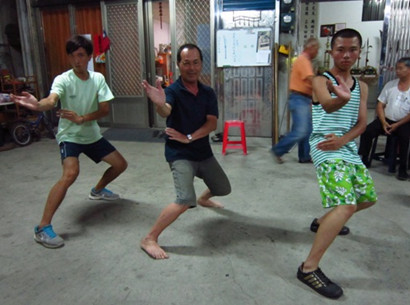
Shu-Mao Cheng, in the middle, is one who works for technique pass-on
However, the lion dancing requires some basic skills of the martial art, or we say the essential techniques, for example the "horse stance", the training thus becomes tough. Some students came only one day and disappeared on the second day. Jian-An Chang said, he would never give up, the zeal at developing this technique will help in collecting Xiashan people to practice together and understand more about their culture.
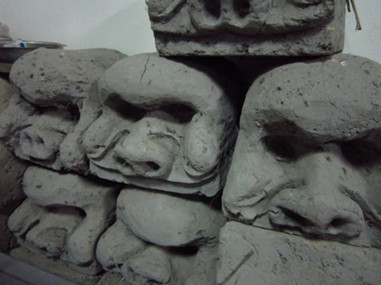
The mode for lion mask made from students
A look into future
Standing on the playground at the middle of rice fields, where Xiashan people get together for practicing of lion dancing, looking around and found at one end of field, there is the HSR (High Speed Rail) that would accelerate the disappearance of the countries. Xiashan has been designed under the urban planning to be rezoned for industrial or commercial use. Xin-Qiao, Ho, the administrative head of Xiashan village said, no farm land no farmer, the martial arts developed in the agricultural village will disappear as well as its spirits. Have no idea for how long the very unique lion dancing specially in Xiashan will keep go on.
With help from the Cultural Affairs Bureau of Hsinchu County, the Xiashen lion dancing has reported as a cultural asset for retention, hopefully this would attract more people to join in to be sustainable.
Under the yellow street lights, Xiashan people is practicing Hakka lion dancing where we can see both male and female lions are covering pieces of clothes with the famous Hakka cotton print. They play and laugh loud, however the laughing voice seems to be out from the lion's big mouth.
| 















